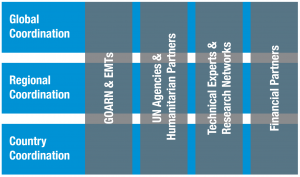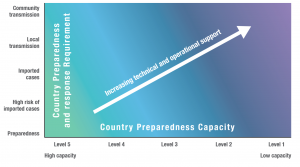Emma Ossola
In this blog I do not want to tell the origins of the Coronavirus or what hygiene measures to take, I think that by now we are all already informed on the subject. Much more interesting, from my point of view, is to analyse how our society, which seems to be able to control everything, is reacting to this pandemic. Every country has different legislations: how are we getting on internationally? How will the nations cooperate? What structures are at the basis of our response plan?
WHO’[1]s response mechanisms to the emergency of COVID-19
The World Health Organization is a UN agency specializing in health problems. The WHO monitors and regulates health risks in all the world (61 countries are part of it). Therefore, it is momentarily at the centre of global political interest. «The protocol for the Control of Infectious Disease Events (April 2019), under which the UN response to the situation would be coordinated by WHO through the mechanisms established under its governance programme. »[2] Since the first case of COVID-19 was reported, the WHO immediately began to collaborate with the Chinese government, to know the capabilities of the virus and decide what response plan to organize.
In order to better coordinate this emergency, the WHO has decided to create management teams at international, regional and national level. At a global level, the WHO coordinates its various partners team called GOARN (agencies, NGOs, the Red Cross, etc. are part of it). In this way the virus can be monitored, diagnosed and controlled. The exchange of information is essential. On a regional level the WHO has several offices that act as a bridge with local organisations and at the same time with the global support team. At the national level, the WHO supports the different countries (if the situation becomes serious, it creates a country-specific support team). It also monitors all possible interconnections between nations (people travelling, imported cases, local outbreaks, etc.).
Figure 1, Strategic Preparedness: Partner coordination

Epidemiological analysis and forecasting are the first steps in order to plan the right response. In the case of COVID-19 scientific research is particularly important, as the virus is a novelty and its possible developments are uncertain. The data collected in these days are essential and serve to develop future action plans. The WHO has set up a global surveillance system where data is standardised. This makes it possible to exchange information daily. It is important for the various Stakeholders to have an official channel of exchange. To cite a practical example: the WHO is creating a mobile-app for people who work closely with the Corona-virus, in order to spread the new official information quickly. Thanks to the data collected, action plans can be developed. The necessary medical and financial supplies can be sent to regions with a high number of cases. WHO has special committees that coordinate the market. Therefore, in the event of a critical good being missing (e.g. face masks or respirators), they try to provide the country with access to the market. In addition, emergency plans will be implemented in the event of a shortage of food and other basic necessities (non-medical). The channels of communication between a nation and its inhabitants are equally fundamental: only in this way can the directives taken be executed quickly and correctly. «Countries should prepare to communicate rapidly, regularly and transparently with the population. »2
Preparedness in the different Countries: the five levels have been chosen to divide the different nations according to how ready they are to respond to the COVID-19 emergency. All nations at risk must be prepared for the Corona-virus emergency, but unfortunately not all of them are. Thanks to this graph (Figure 2) it is possible to identify countries at risk and at the same time unprepared. These countries will consequently need more aid.

Two important WHO support structures
The Global Health Crises Task Force [3]is a report made by an assembly that was called by the Secretary General of the United Nations in 2016, for a period of 1 year. Its objective was to create and structure a plan of action to be followed in the event of a global health crisis. «The purpose of the Task Force is to monitor, coordinate and support the follow-up and implementation of the recommendations of the High-level Panel on the Global Response to Health Crises (“High-level Panel”), issued in its report on “Protecting humanity from future health crises”. »[4] In the report submitted to the Secretary General, the Task Force has also worked on issues that support the World Health Organization (“WHO”). They have in fact created a Panel of recommendations for the United Nations (“UN”) to follow in the event of a health crisis. These precautions aim to support the WHO’s emergency programme. Another of the proposed objectives has been to mobilise financial resources to support the WHO. In general, the objective of the Task Force has been to create a highlight of recommendations that has a comprehensive view of the different Stakeholders, the different action plans (regional, national and international), the size and degree of the health crisis, the financial resources available, and the exchange mechanisms between nations. This highlight will help the WHO and the UN in the case of a global health crisis such as the COVID-19.
The Global Coordination Mechanism on the Prevention and Control of Noncommunicable Diseases [5] is a tool created in 2014 by the World Health Assembly, that helps the different Stakeholders to communicate with each other. Essentially it is an online platform where the so-called “Noncommunicable Diseases” are processed and managed. UN organisations, WHO member countries, Academic institutions and also the most important actors in the private sector are Stakeholders of the GCM/NCD (there are more than 450 participants)[6]. These do not necessarily have to do with the health sector. In the GCM/NCD, a broad point of view is specifically sought, where all the interests of society are considered. «Through these fora, key stakeholders discuss strategies aimed at helping countries to realize their high-level political commitments and supporting national efforts to develop and implement domestic solutions and mobilize resources to prevent premature deaths from NCDs. »[7] These goals are then taken into account by the WHO or even by the UN, which then decide how to act. In just 5 years of life, GCM/NCD has gained a lot of political relevance, proving to be a useful tool of government. This structure makes it possible to coordinate health protection measures at a global level and at the level of the entire population (as mentioned, not only the health sector is considered). As such, it is an essential aid to deal with the COVID-19 emergency, which requires major sacrifices for the entire population.
Conclusions
Every nation in a normal situation is responsible for itself. As can happen, however, anyone can find themselves in difficult times, even the wealthiest countries (e.g. Switzerland at the moment). In such situations one can no longer think only for oneself (the COVID-19 is a health emergency that is affecting the whole world). Fortunately, international structures have already been set up for such cases. Associations such as the WHO are therefore essential, because they allow coordination and collaboration on an international level. From this negative experience, we have a lot to learn. One of the things we have to learn is that the world is actually made up of only one nation.
References
- GLOBAL HEALTH CRISES TASK FORCE Workplan
- STRATEGIC PREPAREDNESS AND RESPONSE PLAN
- OPERATIONAL PLANNING GUIDELINES TO SUPPORT COUNTRY PREPAREDNESS AND RESPONSE
- 2014-2019: 5 Years of The Global Coordination Mechanism on NCDs
- www.un.org
- www.who.int
[1] WHO, The World Health Organization
[2] Dokument: STRATEGIC PREPAREDNESS AND RESPONSE PLAN
[3] The Global Health Crises Task Force or shortened Task Force
[4] Dokument: GLOBAL HEALTH CRISES TASK FORCE Workplan
[5] Global Coordination Mechanism on the Prevention and Control of Noncommunicable Diseases or shortened GCM/NCD
[6] Individuals cannot become members, only entities.
[7] Dokument: 2014-2019: 5 Years of The Global Coordination Mechanism on NCDs
posted by Emma Ossola
Media Attributions
- Figure 1, Strategic Preparedness: Partner coordination © World Health Organization 2020 is licensed under a CC BY-NC-SA (Attribution NonCommercial ShareAlike) license
- Figure 2, Strategic Preparedness: Country risk and vulnerability mapping © World Health Organization 2020 is licensed under a CC BY-NC-SA (Attribution NonCommercial ShareAlike) license